~Let’s take a glimpse into the world of Kaiseki cuisine~ ~懐石料理の世界を覗いてみよう~
Welcome to the Tea Ceremony Time!
My name is Sayaka Sakai, and I am the owner of the Tea Ceremony Time.
This tea room is a place where you can learn about the tea ceremony from various angles.
I would appreciate it if you could join me until the end.
茶室へようこそ!
Tea Ceremony Room主催者の酒井沙弥香です。
この茶室は、茶道をさまざまな角度から学べる場所です。
最後までお付き合いいただければ幸いです。
「茶懐石」chakaiseki
The story of a tea ceremony practice session 茶道の稽古の話
In regular tea ceremony practice, we divide the ‘chaji’ into parts and practice each separately. This is called ‘wari-keiko’.
通常の茶道の稽古では、茶事をいくつかの部分に分け、それぞれ別々に稽古します。
これを「割り稽古」といいます。
Understanding the entire flow of the ‘chaji’ and becoming able to perform it oneself is also one of the goals.
茶事全体の流れを理解し、
自分でもできるようになることも目標の一つです。
A ‘chaji’ is a hospitality event held in a tea room, and it typically lasts for about 4-5 hours. It includes the charcoal preparation, the kaiseki meal, the thick tea, and the thin tea, allowing participants to enjoy the complete tea ceremony experience.
「茶事」とは茶室で行われるもてなしの行事で、通常4~5時間ほど続きます。
炭の準備、懐石料理、濃茶、薄茶が含まれ、
参加者は茶道のフルコースを楽しむことができます。
~chakaiseki~ 茶懐石
Today, we will talk about ‘chakaiseki,’ which is the most time-consuming part of the ‘chaji’ in Japanese tea ceremony.
今日は、日本の茶道の「茶事」の中で最も時間のかかる部分である
「茶懐石」についてお話します。
①The serving of the meal ごはんと汁物
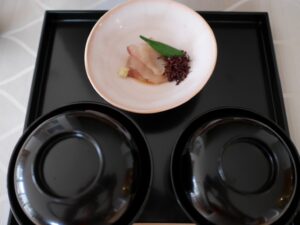

At first, rice, soup, and a small dish (mukozuke) are served. At this time, guests do not use their chopsticks to eat the small dish until sake is served. Guests eat the rice and soup alternately and leave a small portion of rice uneaten at the end.
まず、ご飯、汁物、小鉢(向付)が出されます。
このとき、小鉢はお酒が出るまで箸で食べません。
ご飯と汁物を交互に食べ、最後にご飯を少し残します。
②The serving of sake and the lifting of the ban on eating the small dish お酒と小鉢の解禁
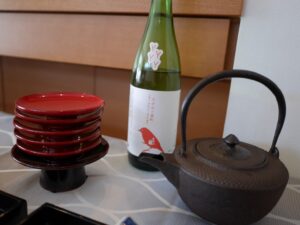
③Nimonowan 煮物碗

④Second helpings of rice and soup 2回目のご飯と汁物のおかわり
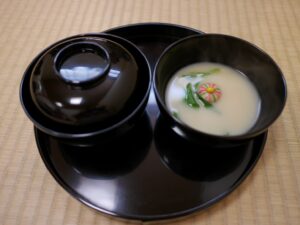
Second helpings of soup are offered only once, while for rice, guests are expected to take just enough to finish in one serving according to the number of people present. If guests wish to have a second serving of rice, they can take as much as they like.
汁物のおかわりは1回のみ、
ご飯は人数に応じて1回で食べきれる量をとります。
さらに行われるご飯のおかわりでは、お好きなだけお取りいただけます。
⑤Yakimono Susumebachi 焼き物、すすめ鉢
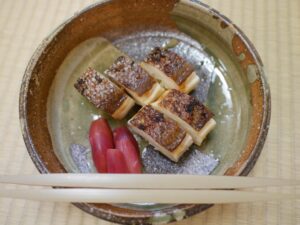

⑥Suimono 吸い物

Positioning similar to ‘hashi-kurabe’ in kaiseki cuisine
懐石料理の「箸洗い」のような位置づけ
⑦Hassun and Chidori 八寸と千鳥

Seafood and mountain delicacies are served as sake accompaniments. At this time, guests share and pour each other’s sake.
酒肴として海の幸や山の幸が出され、客同士で酒を注ぎ合いながら酒を酌み交わします。
⑧Yutugi 湯次

Positioning similar to the final ochazuke (rice with tea) dish. Guests pour tea into their rice bowls and soup bowls to cleanse them and to enjoy a final dish of ochazuke.
最後のお茶漬けのような位置づけ。
お茶碗や汁椀にお茶を注いで清め、最後のお茶漬けを楽しみます。
⑨The removal of the dining utensils 食器の片付け
The guests signal to each other with their chopsticks, and then simultaneously drop them into the tray, making a sound to alert the host of the end of the meal.
客は互いに合図し、同時に箸をトレイの中に落とし、
食事の終わりを主人に知らせる音を立てます。
⑩Wagashi 和菓子

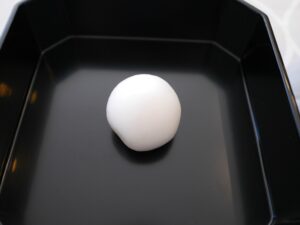
The above is the flow of the kaiseki meal according to the Omotesenke tradition. There are many thoughtful details throughout, making it an enjoyable experience!
以上が表千家の伝統に則った懐石料理の流れです。
随所に気配りが行き届いており、とても楽しいひとときをお過ごしいただけます。
Did you enjoy it?
That concludes my tea ceremony for today.
I am looking forward to seeing you again.
楽しんでいただけましたか?
本日のお茶会はこれで終了です。
またお会いできるのを楽しみにしています。
If you would like to watch the video, please click here▼
動画をご覧になりたい方は、こちらをクリックしてください▼




